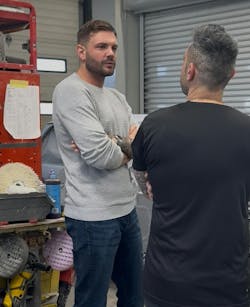How Can Collision Repair Attract Talented Next-Gen Techs — and Keep Them?
Key Highlights
- The collision repair industry needs to improve its public image to attract new talent and dispel stereotypes of low skill and a dirty work environment.
- Young technicians seek opportunities for growth, clear career paths, and recognition, rather than just financial incentives.
- Shop owners should foster a team environment with challenging tasks, incentives, and visible career development plans to retain young techs.
- Building relationships with schools and training programs, including encouraging women and teachable individuals, can expand the talent pool.
- Leadership quality is vital; managers should evolve into leaders who inspire, develop, and adapt to industry changes like electric vehicles.
The collision repair industry has an image problem to fix. That’s the opinion of Dan Wittek, director of global application engineering for 3M Automotive Aftermarket Division in Maplewood, Minnesota.
The trouble: as a culture we haven’t historically viewed collision repair as a promising career destination. In fact, quite the opposite, and Wittek knows it firsthand.
“I grew up very artsy-craftsy and I was also good at science and math,” Wittek describes himself as a kid. “But I always enjoyed hands-on [work].”
Enter a 1983 Datsun, his first car.
“It was a complete pile of junk, but I did my best to mold it. I had more interest in that than mechanical engineering,” Wittek shares. So, he told his parents that he wanted to take a different route with his schooling — one that bypassed the engineering program they planned for him at the University of Minnesota.
“My parents almost died,” Wittek states of his plans to get a crash course working in a body shop instead. At school, he got the same reception. “My high school guidance counselors said, ‘No, you can’t do that. You need to go to college.’”
Wittek believes he’s not alone in his experience — and that to grow top talent for the collision repair pool today, shop owners and schools must work together to erase the stigma.
“Even from movies and the media, the look of repair shops is not good,” he notes. “Collision repair centers are publicly viewed as dirty, -the mechanical stepchild of the skilled trades.” And he adds of everyone involved in the industry, “It’s our responsibility to help position our industry in a better, more responsible light.”
Making collision repair look like a rock star
Wittek, of course, didn’t listen to his parents and school counselors in the 1990s, and he did go into collision repair. Then later, as an adult, he added that engineering degree. Together, the two vocations have given him a unique vantage from which to see and gauge what up-and-coming auto body techs need to succeed.
In addition to his work at 3M today, where he spends 80% of his time focused on collision repair, Wittek serves as a SkillsUSA (national workforce development organization for students) committee member, and has since 2007. He also works closely with its auto refinishing technicians contest, as well as with the local SkillsUSA contest in Minnesota. So, he’s doing his part to build up the industry and people’s fresh, new awareness and perception of it.
“This is a fantastic, fun, and creative trade,” Wittek stresses. “Society is changing and adjusting to that.”
As collision repair moves beyond its second-class-trade image, though, kids keep changing, so much so that it’s hard to tell what an actual rock star looks like to them anymore.
Wittek, though, says he knows the students he comes across are looking for these three things to be present in their careers: opportunities for growth, a clear career path, and rewards.
“So, to have somebody new come in [to your shop] in an entry-level position and be seen as the person who just does prep work, cleans floors, and who has no vision of what their future looks like, that’s a big risk in terms of holding onto talent,” he cautions.
The nuts and bolts of what young techs need
Essentially, young techs today want to feel like they’re on a career path that can put them in the driver’s seat of their own lives, according to Jason Duffy, managing principal of Collision Action Group in Chelmsford, Massachusetts, a recruiting and consulting firm for the automotive industry. Leading up to this role, Duffy was an aircraft mechanic in the military until he found collision repair, and he never looked back.
“Today’s young techs are looking for identity and respect. It’s the generation we’re going through,” Duffy states. “They’re looking for a culture opportunity and a chance for a [career] that grows into something more than turning a wrench.”
That means today’s techs are looking for a collision repair company that’s growing, where they can be a part of something and feel good about their direction there.
“They must see this pathway and know they’re on it,” Duffy emphasizes.
And according to Wittek, “When shop owners help create a better environment, young techs can see that this is one of the most fantastic and fun trades.”
Collision repair is vibrant and creative in Wittek’s and Duffy’s worlds — and both encourage shop owners, schools, and everyone associated with the trade to make sure that’s what young techs see and experience when they walk through the doors.
What else makes a young tech tick?
Today, an insurance card and a 401(k) are not what the new generation of workers are after — and they’re not what can make young techs stay.
“These things are not what’s on young techs’ brains today,” as Duffy puts it. “If you give them responsibility, they like that. They want to be treated like adults. You have to let them fall on their face in a gentle way and don’t micromanage them. There’s a psychology behind it.”
But how can a shop owner provide these things for young technicians and still get the work done right?
“One shop I know is turning its techs into a team,” Duffy says. “He knows that if there’s nothing challenging going on, it’s boring [for young techs]. So, he makes the team like a tryout, and he gives new techs these tasks they’ve got to do, and so many they have to complete within the day, and then when they do, they get to shadow someone on the team.”
This way, the seasoned team of techs can easily identify the young techs who have drive and who will be an asset — and they want them onboard.
“So, the new tech then gets to ‘enter the club’ and they’re part of something,” Duffy notes. “Today, it’s more about calling out the wins and doing it publicly.”
Wittek says when shop owners offer incentives and have active development plans in place that it helps attract young techs today. “If you do this, we’ll reward you with that,” is the idea, he says. “Shops need to present a visible career path where techs can see a future, practice their craft, and see themselves as able to support themselves and a family.”
To find potential new techs who possess this kind of vision, Duffy says it’s wise to look for individuals who are teachable.
“We don’t necessarily go straight to the trade schools, but we go after athletes who are coachable,” he says. “We look for humility, curiosity, and pride. And we go for people who are hungry [for a career]. We’re hiring off a culture and potential.”
When it comes to schools and other training programs, Duffy encourages shop owners and managers to start by developing good relationships with the teachers. “That way, you can let students know what the market actually looks like.”
He also advises owners to keep an eye out for women techs today who are interested in the trade.
“I like seeing females getting into the mix in a good-cultured shop where there’s respect across the board,” he says. “The mix helps bring more energy across the shop and it builds a family [culture].”
Wittek agrees. “If we want to attract and grow the workforce, we need to dig deeper. We need to put the industry in a favorable light and get those interested in science and technology for cars today.”
Self-reflection is a good idea, too
As Duffy says, “If you’re a shop owner reading this, stop looking for the perfect tech to come walking through your door. Look in the mirror and ask yourself, ‘Am I somebody who they’d want to work for?’”
At the end of the day, it’s not only the new young techs that are changing and who must continue to adapt within the industry; it’s leadership and management, too.
“We expect our techs to grow and adapt to ever-changing vehicles like EV,” Duffy closes. “So you should also be growing and becoming better as a leader. There is no room for managers anymore. Only leaders.”
About the Author

Carol Badaracco Padgett
Carol Badaracco Padgett is an Atlanta-based writer and FenderBender freelance contributor who covers the automotive industry, film and television, architectural design, and other topics for media outlets nationwide. A FOLIO: Eddie Award-winning editor, writer, and copywriter, she is a graduate of the University of Missouri School of Journalism and holds a Master of Arts in communication from Mizzou’s College of Arts & Science.


